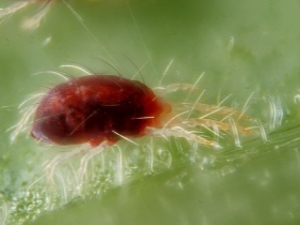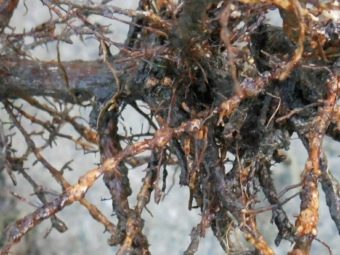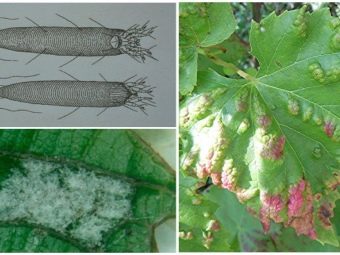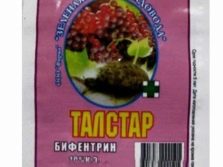Grape mite: varieties and methods of eliminating pests

Currently, the cultivation of grapes has become very popular not only in countries that traditionally cultivate it, but also in Russia. The agricultural experience in the breeding of new frost-resistant varieties made it possible to significantly expand the boundaries of its cultivation.
Description
Growing grapes is often complicated by pest control, the number and variety of which is enormous. There are almost 800 species of various insect parasites. Pests affect all parts of the plant, from the berries to the roots. The foliage, shoots, and inflorescences can also be affected. Losses in yield without controlling such pests can be huge - 30-50%, and sometimes the entire vineyard can die. Therefore, pest control is of great importance and must be competent in terms of the prevention and treatment of plants.
Herbivorous mites most often affect vines. They live either on the leaves, or inside the buds or galls, which are formed in damaged areas. Eating plant sap, the mite destroys chlorophyll, leaves deform, dry and fall. At the same time, the process of kidney formation is disturbed and the yield is significantly reduced. Grape mites are a huge and diverse order of insects. In addition, ticks can be carriers of various harmful bacteria and pathogens (mildew, powdery mildew).
One type of grape mite is pruritus. It refers to the type of mites that cover the leaves with a thin spider coating, similar to felt. Therefore, the itch is another name - felt. It is possible to determine the places affected by itching, even by eye on fuzzy spots on the leaves. In appearance, the felt mite resembles a worm, it has the same oblong body - up to 2 mm in length, of a light, almost transparent color, less often of a yellowish tint. The pincers are bisexual, the female differs from the male in a somewhat larger size.
The grape seedlings may already be a carrier of itchiness. Starting its livelihood from early spring, the female mite can lay eggs on the leaves of young shoots, less often on inflorescences already at a temperature of 7-8 degrees Celsius. At the same time, buds of inflorescences are destroyed, as well as shoots. They turn red, thicken and then fall off.
Damage done
The infection of the grapes with itching begins with the leaves, then moves to a bunch of grapes through its crest. The disease spreads very quickly. This is explained by the fact that enzymes are present in the mite's saliva, which act on the leaves of the plant, which leads to their curvature. Places affected by the felt mite are round or oval in shape, the pigment disappears from the leaves, they become thin, acquiring a white color. As a result, the leaves dry out and fall off.
In the place of the leaf bite by a tick due to the impact of saliva, a white pile appears, which then turns into a brown color. Usually the itch is on the inside of the leaf of the vine. And on the upper surface of the leaves there are spots that have a convex shape in the form of tubercles. These tubercles then become yellow-brown. The process of defeating the itchy grape blossoms is the same.
Feline tick infestation may be to a lesser or greater extent. If it is very large, it covers the whole sheet, which is then folded and hung. First, mites infect the lower leaves, then gradually move to the upper parts of the vine.
Intensification of infection with itch is promoted by high air humidity. In a rainy summer, felt mites can turn into bunches of grapes, which are covered with felt down and lose their usability. Strong wind can help the expansion of tick colonies. As a result of large-scale contamination, the crop drops sharply, the quality of the grapes decreases, and the roots may suffer.
Ways of deliverance
To prevent the mass spread of the tick, to prevent the death of the vine and the crop, it is necessary to start a fight with it at the first sign of its appearance. If the tick has hit a small amount of vines, then the main and effective measure of the struggle will be the breaking off of the infected leaves of the grapes. But if the defeat covered large areas of the vineyard, then a good method would be to spray the chemicals. Need to spend it several times.
The main condition for mite removal is spraying the inside of the leaves. An effective means of combating felt mites is the use of sulfur preparations. Sulfur treatment is carried out at temperatures above 20 degrees 2 times with an interval of 10-14 days.
Treating a vineyard tick begins with the lower sections of the vine. If it is successful, the newly bloomed leaves will be healthy. From the point of view of agrotechnology, the methods for combating felt mites are as follows:
- do not allow the shoots of grapes to lie on the ground, which will reduce the risk of tick infestation;
- in the autumn and spring months regularly dig up the earth under the grapes;
- carry out timely pruning of shoots and dried leaves, clean the trunk and woody shoots of obsolete bark;
- fallen leaves, cut off shoots, bark must be burned in the fall.
In the autumn, prophylactic spraying of the carbolineum is carried out. Processing the vine with a solution of lime (5%) after the leaves fall also has a good effect. If these types of processing were not carried out in the fall, then in the spring it is necessary to spray the grapes with a colloidal solution when the shoots reach 5 centimeters.
There are also folk remedies to combat itch. Basically, these are fairly simple, free and safe measures.
For treatment of the trunk, tree shoots and leaves using an aqueous extract of onion peel. It is prepared very simply: onion peel is filled with water and infused for about 3 days.
Tincture of marigold flowers (marigolds). Preparation: 0.5 buckets of dried calendula filled with a bucket (10 liters) of warm water. Infused 2 days. About 50 g of liquid laundry soap is added before spraying. Spraying is best done in the evening.
Typically, such methods of dealing with a tick help, if the defeat has a small size.
Treatment
To combat the tick there are a large number of chemicals, both potent and gentle plan. The following drugs can be considered benign: "Bi-58", "Delitan", "Zolon", "Omite", "Neoron". The method of using these drugs is the same and is specified in the instructions for them.
Sulfur is also widely used. The principle of its impact on ticks is that when it penetrates the parasite's cell, it interacts with oxygen, and hydrogen sulfide is released, which has a detrimental effect on the tick. There is also a drug "Tiovit" on the basis of sulfur, the principle of its action is the same.
Potent drugs should be used with caution. Such a drug is Actellic (Vertilek). It is necessary to spray the grapes with this preparation if the infection is very large and other means have not helped. This drug is dangerous to humans and beneficial insects (bees), so you need to take precautions.
Timing
In terms of processing is carried out as follows:
- In the spring, even before the buds bloom, it is necessary to treat the grapes with the drug “Dnok”, and during the bud blooming - with the “Aktellik”.
- At the very beginning of the growth of shoots, when they reach a length of 5 cm, they are treated with colloidal sulfur.
- During the growing season, the use of such drugs as Apollo, Talstar, Mitak, Omayt, Pliktran, Fosfamimd and others is effectively used to destroy the tick.
- In the summer months, when itching occurs on a large scale, spraying with acaricides or insecticaroacaricides is used.
- In the autumn, the vine is treated with a solution (5%) of lime decoction.Spraying is done after all the leaves have fallen off, the trunk and tree shoots will be free from foliage.
Process
Properly organized processing process will bring the best results in the fight against ticks. In order not to miss the day of spraying the grapes, keeping a calendar will be the best way. It is also necessary to observe the doses specified in the instructions for drugs. Too much will cause harm, and not enough will not be effective. It is better to use some preparations in hot time, for example, "Nero", "Akarin". Sulfur also brings a positive effect only when it is used at a temperature of +30 degrees and above, at which sulfur vapors are formed, causing death and itchiness, and its larvae.
When spraying you need to follow some rules. It should be produced by a strong jet, aimed at both the outer and the inner surfaces of the leaves, where, in fact, there are mites, and be abundant. Start spraying you need from the lower parts of the grapes, rising up. This can be achieved by placing the spray injector near the surface of the earth, progressively lifting up and spraying the inside of the foliage.
In accordance with the size of the vine will need 2-5 liters of solution. Spraying is best done in the morning (up to 10 hours) or in the evening in the interval 18-22 hours with no wind. The number of grape treatments depends on the spread of itching. Maybe one is enough, but it may take several. Chemicals bring good results when used together with agrotechnical measures.
Security measures
When spraying the vineyard with chemical preparations, it is necessary to strictly observe safety measures, since these preparations are dangerous to humans. You must adhere to the following rules:
- All chemicals are kept out of reach of children in tightly closed containers.
- Storage of these preparations together with food and animal feed is unacceptable. To create solutions you need to use specially designated for this dish.
- Before spraying, wear waterproof clothing (preferably clothing) that covers all areas of the body. Cover the head with a hat covering the hair.
- Eyes must be protected by safety glasses. A mask, respirator or medical bandage is put on the face. Wear gloves to your hands.
- During spraying it is strictly forbidden to smoke, drink water or eat food.
- When carrying out spraying it is worth considering where the wind blows, and avoid splashing the preparation on other people.
- After the end of treatment, all the clothes in which the work was carried out are ventilated, stretched in water with the addition of a soap-soda solution. Capacities from under the preparations are treated with soda solution (50 g per 1 l of water). Then rinse thoroughly with water.
Gardeners tips
Many gardeners who like to grow grapes, share their experiences in the fight against grape pruritus:
- When you first change the color of the leaves you need to start processing the grapes, since the violation of the photosynthesis process has already occurred. In this case, it is effective to use acaricidal preparations - Bi-58, Actellic, Nerod, and others, as well as sulfur preparations.
- Such an extraordinary remedy as predatory mites (phytoseymos, Amblyseius Californian, Amblyseius MacKenzie and others) that feed on itch larvae helps fight itching.
- In order to prevent the occurrence of itching, plants that scare ticks are widely used. These are onions and garlic that are sown near the vine.
- To combat itching, you can use the tested drug "Envidor". It is effective against ticks and at the same time not so dangerous for humans. Another effective drug is the biological agent Gaupsin. They are treated with grapes during flowering for the first time, then after flowering once a week.
- It is better to grow American varieties of grapes that are resistant to itchiness: “Lora”, “Arcadia”, “Nizina”, “Augustine” and others.
- Regularly loosen the ground under the grapes, and keep the space between the rows periodically under the black steam.
Grapes - a plant that requires great care and care. Only through tireless work can you achieve excellent results in the cultivation of this sensitive fruit.
For information on the types of grape mites and how to deal with them, see the video below.

















































